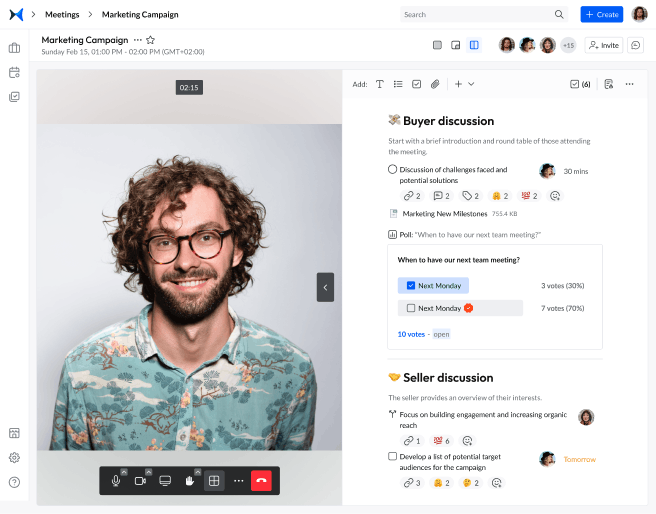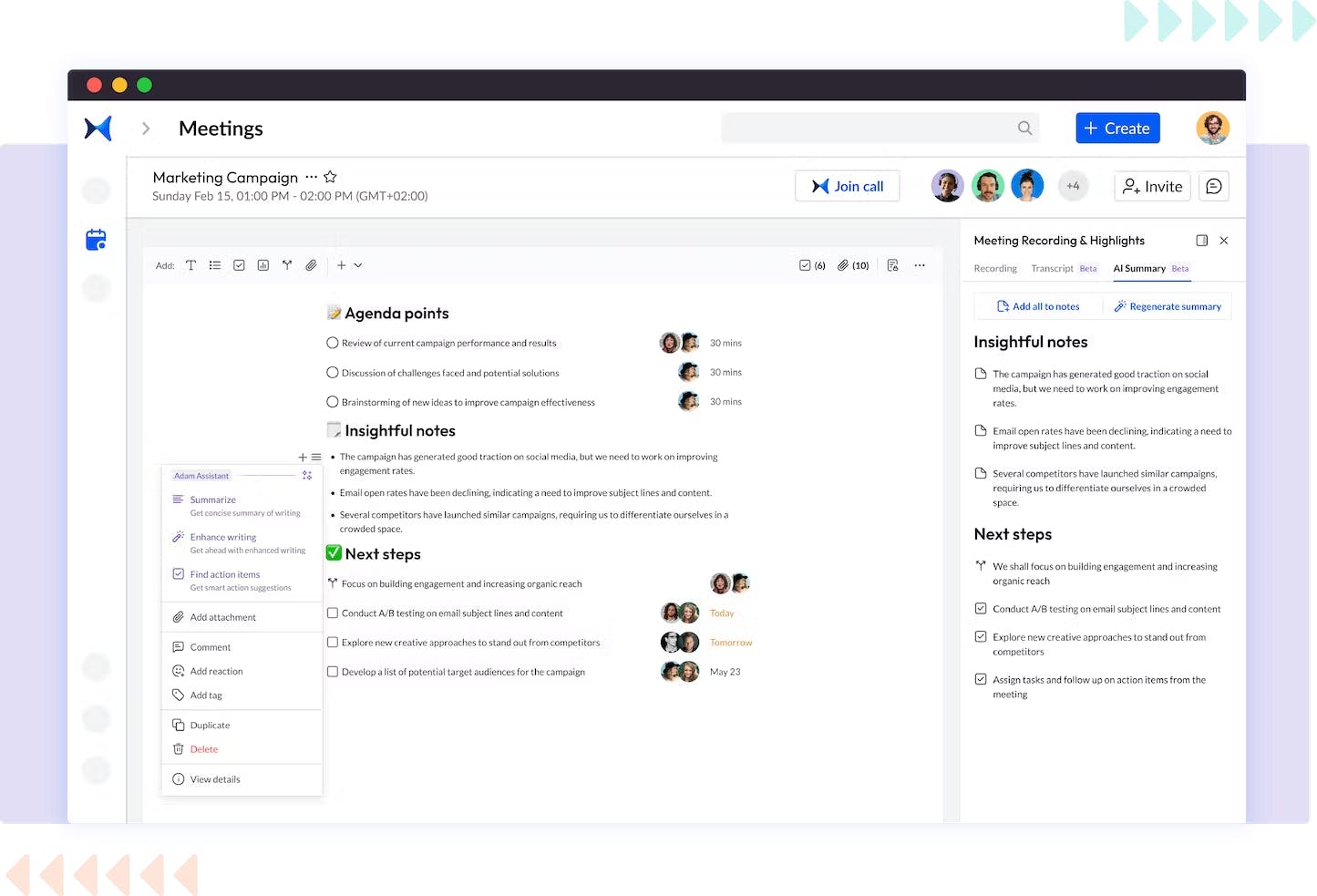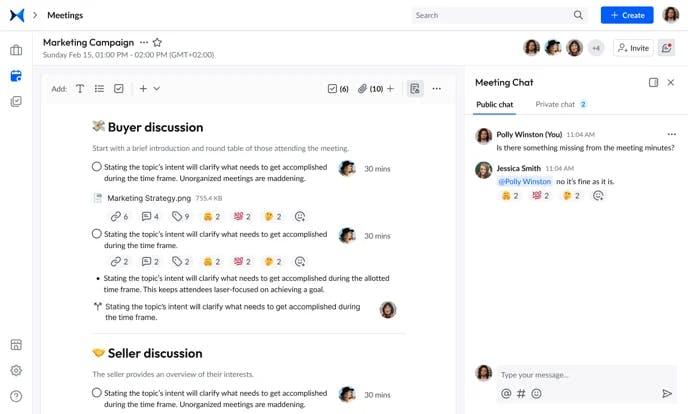September 14, 2021 · 19 min read
All Remote Meetings Questions Answered (+Best Practices & Tools)

Laila El Tawil

The "you know what" has made offices everywhere transition to the work-from-home mode — the majority doing so for the first time. Adjusting to remote work is challenging for workers and managers who are used to face-to-face contact.
Remote meetings were the answer to this new work model, with tons of tools and solutions invented everyday to facilitate the remote work process and guarantee a productive remote meeting every single time.
What is a remote meeting?
A remote meeting, or a virtual meeting, is one when a group of people use video and audio to connect online because they exist in different locations.
Remote meetings are a good option for organizations with remote or hybrid teams, agencies that need to connect with clients, freelancers who need to meet with their customers, or business partners who are located in different cities, states, or even continents.
When it comes to the way of communication, remote meetings normally take three different-in-style, similar-in-essence types.
What are three types of remote meetings (communication)?
Here, we're differentiating between remote meetings' types based on the way of communication, not the purpose of the meeting (which is covered further down this article): teleconference, video conference, and web conference meetings.
1. A teleconference meeting is an audio-only virtual meeting that depends on a phone service, an instant messaging app, or a conference network.
2. A video conference meeting is favored by millions around the world, where users use an internet connection to virtually meet through their cameras, real-time chat, and share files and screens.
3. A web conference meeting is hosted on the internet also to allow distant participants to collaborate using their mobile devices or PCs, where video sharing is optional.
Well, regardless of its type, here's how to run a remote meeting.
For managers: How to conduct remote meetings?
Now you, as a manager or team leader, need to organize and hold a meeting remotely with someone or some people at a different location than yours, how should it go?
How do you maximize the efficiency of the meeting? How do you make sure that everything is covered and clear before everyone disconnects? What tools should you use?
Let's take a look.
1. Choose the right online meeting tool
Among the abundant tools available in the market to start and manage an online meeting, the key is to choose the right tool for your team.
First, think about the reason you are holding this meeting, the key functionality needed for the success of the meeting.
Is the team collaborating on a project that needs the input of everyone? Are you displaying a presentation in real time? Or you could be showing a client the prototype of a product and need to see their reaction.
Hence, choose the online meeting tool that best fits your needs: Google Docs, screen-sharing software, video conferencing tool, or else.
Second, estimate the number of attendees who will be present at the virtual meeting. Some meeting tools are specifically designed for 1 to 1 meetings, others are for +100 members.
Third, determine what additional features you need to have a seamless meeting experience and end up with a productive outcome.
You'll need a tool that helps your team stay focused, collaborate easily, and share ideas. You could also use some screen-sharing and recording capabilities. Documentation and accountability are, likewise, crucial here. The tool should also make it easy for the whole team to access this meeting's knowledge and content afterwards.
🔎 Real-life example. Joshua, an IT manager at a software company, needs to conduct a remote meeting with his team, made up of 25 members. The purpose of the meeting is to test the new release, share feedback, and discuss next month's tasks.
Josh uses adam.ai as a meeting management software. Through the app, he creates the agenda, sets time for each item, and shares it in advance. He uploads some files as well. During the meeting, everyone is participating and all content is captured smartly. His meeting turns out to be productive and meaningful.

Screenshot from adam.ai: Meeting room.
2. Test the technology in advance
Most of the time, meeting management tools are effective, but there are snafus!
Make sure you understand how the technology works ahead of time, including options like how to mute participants or whether to record the meeting.
Run a test meeting if you have to, so you have confidence in the process.
On the day of the meeting, set up the technology well in advance of the meeting time. Test your audio and video. This way if something isn't working right, you have time to troubleshoot.
3. Pick a time that suites different time zones
The luxury of working remotely has redefined how meetings are held and run. Leaders and managers find themselves struggling with a team that's spread across multiple time zones.
To manage a successful remote meeting, you'll need to pick a time frame that works for everyone's time zone.
🔎 Real-life example. Joshua, the IT manager, is scheduling a remote meeting with a big-shot consultant from Brazil, the mobile app developer who happens to be at his parents' in London, and himself, located in the US.
Josh uses Every Time Zone and schedules the meeting at 10.30 am USA time, as it's 6.30 pm in London and 2.30 in Brazil. This way, he's sure that the meeting time works for all attendees.
But, what is the best time to conduct meetings with remote attendees?
Here are some handy tools that show you different time zones across the world, so that you are able to schedule meetings with remote attendees successfully:
Do it like a pro. Schedule remote meetings 2 days in advance, so that participants have sufficient prior notice and are less likely to reschedule. Mention in the meeting invitation that attendees from different time zones are invited to the meeting so there is little room for rescheduling.
4. Schedule meetings in advance
Last-minute meetings are sometimes necessary but should be avoided whenever possible.
Scheduling meetings in advance allows everyone to prepare for the meeting, which is important because setup for remote meetings is more complicated than walking down the hall to the conference room.
Workers, who may be at home with children and spouses, need to find a quiet place where they can listen uninterrupted. They need headphones to reduce background noise. They need to connect to the meeting software and troubleshoot any problems that may arise with video or audio.
Trying to make this happen at the last minute is a recipe for disaster.
5. Limit attendance
A best practice for meetings in general is to limit attendance only to those whose presence is critically necessary.
This holds true for remote meetings as well — only those who are impacted by an initiate should be on a call. Otherwise, employees are likely to become demoralized or unproductive if they sense that meetings are irrelevant to their roles.
6. Set an agenda
We have been stressing over and over again the importance of setting an agenda for the meeting and sharing it prior to the meeting with the members.
A meeting agenda is a detailed plan for the meeting to be held, set by the meeting coordinator or creator.
Planning an agenda guarantees that the meeting is going to be efficient and successful, the participants stay focused and have a clear idea of their roles and responsibilities, and your time is not going to be wasted.
A typical meeting agenda includes:
- Recurring items, like attendance and status updates.
- Unfinished business, like hiring and planning processes.
- New topics, future planning, and ideas.
An agenda should link to any documents you wish to present during the meeting, so attendees can review in advance.
If employees are expected to share research or reports in the meeting, communicate this when sending the agenda so everyone shows up to the meeting prepared.
Here's the only editable team meeting agenda template you'll ever need, in addition to some best practices for how to stick to your agenda.
Another great resource is this guide to creating effective board meeting agenda, plus an editable board meeting agenda template.
Enjoy!
7. Agree on remote meeting guidelines
Remote meeting attendees need to have clear guidelines about how they are expected to behave during and contribute to the meeting.
🔎 Real-life example. In his remote meetings, Josh sets the following guidelines and communicates them clearly before every meeting:
- The meeting coordinator calls on each member when it's their turn to contribute.
- Meeting members cannot interrupt speakers; they may raise their hands and the coordinator calls their names.
- Members are required to turn their cameras on all the time because he believes that body language and facial expressions matter more than the tone of voice does.
- Everyone, including the coordinator, should mute their microphones to avoid noise and disruptions.
On the other hand, Tess, the marketing head at the company, lays down the following guidelines when it comes to her remote meetings:
- We are all grownups here, so feel free to talk and contribute whenever you like; just make sure you're following general courtesy.
- You are required to turn your cameras on; we can all use some friendliness and expressions in the meeting.
- Unless you are surrounded by loud noises, do not mute your microphones; the "hmm" and "ha ha" make the speaker feel they're not speaking to themselves.
Exciting, ha?
Well, here's more on virtual meeting etiquette best practices.
8. Communicate instructions clearly
While many employees may already be familiar with meeting management software, not everyone has the same comfort level with technology.
To host the most effective remote meeting possible, send instructions on how to use the meeting technology you've chosen. This way, those who are unfamiliar with the enterprise meeting management software or performing remote work for the first time can familiarize themselves with the technology before the meeting.
This saves time in the meeting because people won't be showing up late, asking for help with audio or video, or disrupting the meeting.
9. Assign facilitators
As the coordinator of the meeting, your hands are full of tasks during the meeting: presenting, discussing, keeping everyone engaged, following up with the team, etc.
Assigning remote meeting facilitators spares you the hassle of having to keep up with each and every little bit during the meeting.
Meeting facilitators can:
- Take notes and write down any questions that come up.
- Guide the conversation and keep everything on track.
- Keep an eye on the participants and organize taking turns to participate.
- Make sure the meeting runs smoothly and seamlessly.
10. Send out meeting minutes or recording
After the meeting ends, the meeting coordinator or one of the facilitators is expected to send meeting minutes or a recording of the meeting, if available.
Traditionally, this was done by collecting individual notes from participants, gathering the files that were shared during the meeting, and taking the note taker's draft, in addition to the agenda, to compile meetings of the minute. Then, the one responsible sends out these minutes by email, adding attendees one by one.
This traditional way involves the risk of lost knowledge, scattered content, and waste of time and effort.
Then, how to make notes of a remote meeting?
Nowadays, your meeting productivity software does the job for you; meeting minutes are generated automatically and shared with all meeting participants with the click of a button.
In addition to that, online meeting tools offer a meeting recording feature, where you can send the recording after the meeting for future reference.
🔎 Real-life example. Joshua takes this to another level. For his important meetings, Josh uses "Adam the AI Assistant" to transcribe the meeting recording feature and generate insights, agenda, actions, and meeting summary on his adam.ai account.

Screenshot from adam.ai: How to generate meeting transcription.
Sending out meeting minutes or recording gives members a clear idea about the outcomes and action items from the meeting.
➕ Check out this great meeting minutes editable template.
For members: How to attend a meeting remotely?
You're not running one now, you're merely invited to attend a remote meeting. How should you prepare?
1. Know your role
Come to the remote meeting prepared, just as you will for an in-office one. Make sure you've read the agenda carefully and understood the topics to be covered.
Know your role and responsibility in the meeting: are you the meeting facilitator, are you taking notes, or are you presenting?
Read the guidelines sent by the meeting coordinator, or ask for some if it's not clear so that you don't run into an embarrassing situation in the middle of the event itself.
2. Familiarize yourself with the tools
If it's your first time using a specific tool the rest of the team is using, or it's your first login on the meeting platform they're using, take some time before the meeting starts to get familiar with the technology and accustom yourself to its usage.
🔎 Real-life example. It's Haidy's first week at the company, on Tess's team. She received an invitation on her email for a virtual meeting with the team on the meeting management software they use, adam.ai.
Haidy logged into her adam.ai account, tried out some of the platform's features, learned more about the product from the knowledge base, and read some articles on the blog.
3. Introduce yourself
Whether it's your first time with these people or someone else is new to the group, introduce yourself at the beginning of the meeting.
When all participants are known to each other, the meeting becomes more friendly and it's comfortable for everyone to talk and share ideas.
4. Speak up
In a physical meeting, your manager could tell from your expressions or eye contact that you have something to add or that you don't agree on a decision.
On a remote one, it's not the same. Rarely would the meeting coordinator know that someone wants to add something unless they speak up.
There is a "Raise your hand" feature on most online meeting providers that you can use, to avoid interrupting your colleagues.
Or wait till the speaker wraps up and says, "I have something to add" or "I don't agree with that."
🔎 Real-life example. Tess is discussing with her team the roadmap for launching the new product after the dev team delivers. Instead of interrupting each other, the team uses the "Public Chat" area in adam.ai.

Screenshot from adam.ai: Public chat.
How to make remote meetings more engaging?
Well, this is the real challenge; in a cold, remote, online meeting, how could you spice things up and make sure all attendees are engaged as well as having fun?
This is the big question that we'll try to answer in this section!
How to keep people engaged in a remote meeting?
1. Allow casual conversations
At the beginning of the virtual meeting, spend a few minutes chit-chatting with the team and checking up on how they're doing.
During the meeting, allow casual comments and laughs; don't be a stiff-necked boss because, as opposed to what you might think, it kills the meeting's spirit.
Casual conversations build the necessary rapport for a successful virtual gathering, generate trust, boost engagement, and deepen relationships among team members.
2. Assign roles to attendees
Include remote employees in meetings by giving everyone a specific job to do during the meeting.
Having a clear purpose for each attendee is the fastest way to alleviate team engagement and increase productivity.
Just make sure that the roles you assign to each member are interactive, straightforward, and frequent, i.e., the job requires the member to interact with other members in real-time, is simple and clear enough for them to figure out and continues from start to finish so that they're engaged the whole time.
3. Adopt a stewardship mindset
Stewardship is, by definition, the job of supervising or taking care of something. Here, we mean that, as a leader, you should take care of your attendees' time by being deliberate in your meeting decisions and making smart meeting choices.
Usually, this stewardship mindset is carefully adopted in big meetings with big customers or investors, when the meeting coordinator never wants these key individuals to feel the meeting was a waste of time.
Otherwise, stewardship is often dropped when meeting with your own team or colleagues.
Being aware of others' precious time and making smart choices and decisions during the meeting make virtual meetings more productive and interactive: set up well before, manage productivity and presence during, and conclude quickly at the end of the event.
4. Reduce meeting length
Research proves that groups working under some level of time pressure actually perform more optimally when it comes to focus and stimulation.
Taking this into consideration, schedule meetings under 25 minutes and create that positive pressure, and stimulate members' short attention span.
5. Mind your tone and mood
As the meeting leader, or coordinator, your mood and tone of voice matter.
Don't be surprised when you notice that your tone is contagious and the team is mirroring your own mood during the meeting because it's proven by research.
Starting the meeting with energy and gratitude increases the chances of a more positive meeting mood state, which, by default, promotes creativity, listening, and constructiveness.
6. Be an active facilitator
This is totally different from the meeting facilitators we talked about above, who take notes and organize turns. What we are going for here is that you, as a leader, should actively facilitate the virtual process and smooth transition between topics and individuals.
How to energize a Monday all-staff remote meeting?
- Call out the member's name to draw them in and keep them engaged, "Haidy, please share your thoughts."
- Keep a tally in hand to make sure every attendee is contributing and all voices are heard.
- Call on people specifically instead of the typical generic question "any comment?" that we tend to use.
- Kindly interrupt people who ramble endlessly or go off course.
This is how you act as a meeting facilitator, making sure that all goes seamlessly.
Does turning video on in remote meetings improve team cohesion?
Yes, it definitely does. Turning on video conferencing, as recommended by John Monahan in his article on LinkedIn, promotes better business outcomes, increases engagement in two aspects, the topic, and the team, makes remote discussions more productive, and enhances team chemistry.
On top of that, using video in remote meetings decreases "social loafing," which refers to our tendency as humans to reduce effort when working in a group.
Turning the camera off during the meeting makes an attendee feel anonymous, hiding in the crowd. This results in demotivation, reduced participation, and increased social loafing.
Ask all meeting attendees to turn their cameras on to improve team cohesion, eliminate virtual barriers among team members, and counter that sense of anonymity.
What are the six types of remote meetings (purpose)?
This is different than the three types we discussed above, where we categorized remote meetings based on the way of communication.
Here, we classify remote meetings, based on the purpose of the meeting, into 6 types.
1. Remote standup meetings
Frequency. Daily or weekly
Length. 10–20 minutes
Purpose. Teams create remote daily/weekly standup meetings to check in, discuss past achievements and future plans for the day/week, solve any blockers holding members back, request help from a team member, and give managers an idea of what everyone is working on.
Advantages. Standup meetings keep everyone in the loop, help detect problems soon, facilitate team building, and alleviate the team's spirit.
💡 Do it like a pro. Ask meeting members to turn cameras on for face-to-face communication, keep the meeting concise, and don't go into too much detail.
2. Remote progress team meetings
Frequency. Monthly or quarterly
Length. 45–60 minutes
Purpose. Leaders schedule monthly or quarterly progress meetings for their teams to check in on initiatives, report on the teams' goals, update the team's progress, reflect on roadblocks or failures, and celebrate successes.
Advantages. Progress team meetings act as milestones for the team's past achievements, set clear goals for the following period, and answer hanging questions, if there're any.
3. Remote brainstorming meetings
Frequency. When needed
Length. 30–60 minutes
Purpose. As the name suggests, virtual brainstorming meetings give room for the team to think together and produce creative ideas for a given project or solutions for an issue. The leader listens to all suggestions and contributions and writes them down on the notes area, a virtual whiteboard, or a Google Doc.
Advantages. Group thinking results in great outcomes when it comes to generating ideas or finding out-of-the-box solutions. In addition, members feel heard and appreciated when they're involved in the decision-making process, which in turn leads to enhanced overall productivity.
4. Remote collaborative meetings
Frequency. When needed
Length. 30–45 minutes
Purpose. Collaborative meetings take place across teams, between 2 or more teams. Teams schedule a cross-team collaborative meeting to work on mutual goals or to sync projects.
Advantages. Collaborative meetings are a good chance for different teams to meet, build rapport, understand the other side of the product, answer each other's urging questions, exchange ideas and feedback, and share accomplishments or updates in a collaborative way.
💡 Do it like a pro. Both teams should prepare talking points, create and send an agenda in advance, and allow plenty of time for questions and inquiries.
🔎 Real-life example. Joshua's team of developers and Tess's team of marketers scheduled a cross-team meeting to align on the recent product launch. On their agenda, they are discussing testing results, launch date, post-launch expected issues and how to handle them, and some minor modifications.
5. Remote hackathons
Frequency. Weekly or upon availability
Length. +90 minutes
Purpose. Hackathons, also known as productive work sessions, refer to blocks of time where the team sits down together to produce work. Traditionally, productive work sessions would take place at the office, but taking the recent events into consideration, teams are scheduling virtual hackathons and they are doing great!
Advantages. A team working together to optimize old blog posts, create a landing page, fix bugs, or write codes yield more productive results than individuals working on their own.
An experienced member of the team can allocate 2 hours weekly for newcomers to log in and ask questions, propose ideas, brainstorm, or ask for help. Hackathons or productive work sessions refresh the team's minds and create a collaborative atmosphere.
💡 Do it like a pro. If you're adopting a hybrid work environment, make sure you turn the video on for remote team members to participate in the productive session with their colleagues.
6. Remote guest meetings
Frequency. When needed
Length. +60 minutes
Purpose. At a guest meeting, the team, or concerning individuals from within the organization, meet up with a guest, or guests, to do business of some kind. The guest(s) could be a client, a consultant, an angry user, or else.
🔎 Real-life example. Josh and Tess are meeting with the client to discuss the product's update, launch date, and marketing budget. They have scheduled a meeting on adam.ai, adding the client as a guest attendee.
The client gets to see the agenda and all the public tiles (notes, actions, and files). Yet, Josh and Tess usually add notes, actions, and files privately, which only they get to see, not the client. Decisions are made, actions are assigned, and minutes are automatically generated and sent to the client on his email, and everyone is happy.
To sum up, we have tried to compile a complete guide for how to meet people when you work remotely and conduct a successful and productive remote meeting.
How to organize a remote meeting was also discussed in detail.
We have also discussed how to make virtual meetings more interactive and how to engage remote meeting participants as successful leaders.
We have classified remote meetings into 3 categories, based on the way of communication, and into six categories, according to the purpose of the meeting.
On this matter, whether you are used to working remotely or the current situation has just led you to, adam.ai helps you and your team to effectively apply those best practices to better manage your online meetings content where your meetings are scheduled with clear agenda, notes are synced between everyone into one body of knowledge in an organized manner, and meetings end with clear actions and decisions, along while integrating with other tools you already use to complete your meeting workflow.
And while there may be multiple meeting management solutions available, here is why adam.ai is the all-in-one meeting management platform you can trust:
- adam.ai is one of Atlassian Ventures' portfolio companies.
- In the meeting management software category on G2, adam.ai has been ranked a leader and a high performer for successive quarters in the past years.
- adam.ai has been included in the Forrester Report in the AI-enabled meeting technology landscape.
- adam.ai is trusted and used by powerful teams and organizations worldwide for all types of critical meetings, like board, committee, project management, and business development meetings.
- And most importantly, adam.ai integrates with your existing workflow, is SOC2 compliant, provides dedicated support and success, and has a free trial option.
Transform how you conduct critical meetings—From meticulous preparation to effective execution and insightful follow-up, adam.ai integrates comprehensive analytics, full customization, and intuitive interfaces with powerful meeting management tools.
Easy onboarding. Enterprise-grade security. 24/7 dedicated support.
Subscribe to adam.ai blog
Stay ahead with the latest insights—get our newest blog posts, tips, and updates sent straight to your inbox.